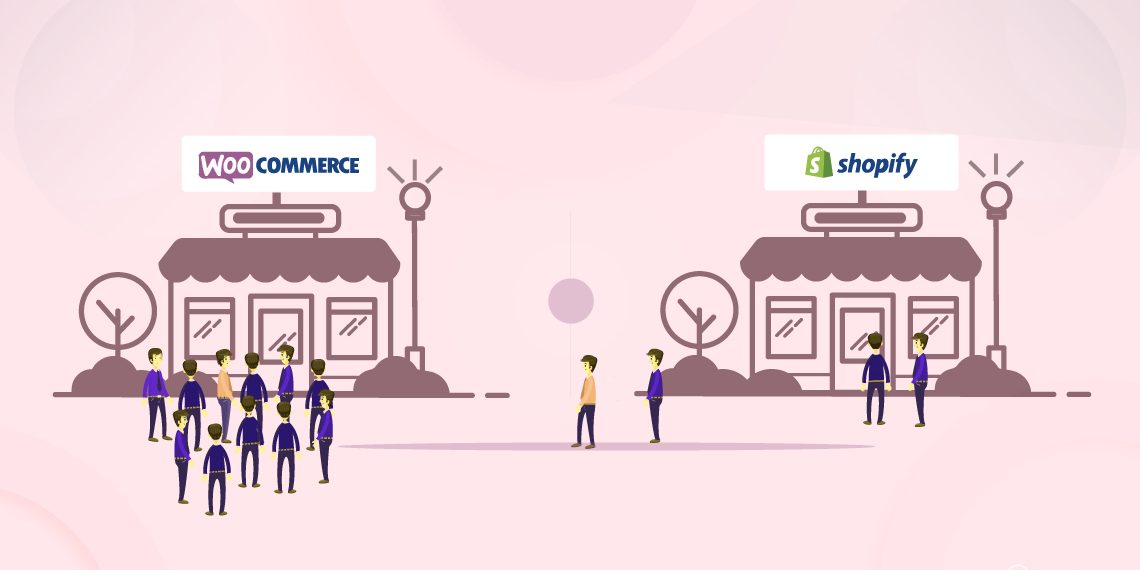It doesn’t take much time to start an eCommerce site as there are plenty of available platforms to start with. But building an online store that is viable and offers great facilities simultaneously for both visitors and the owners is a complex task. Amidst so many platforms out there the good ones can be narrowed down to just a few. WooCommerce and Shopify will spearhead the list with a huge market share.
Despite offering people to build similar kinds of eCommerce sites, these two platforms are unique in their own ways. Their differences lead the users to choose or switch one platform from/to another. The choices of people may vary but some features, limitations, and functionalities determine the future of the eCommerce sites built with them.
Shopify and WooCommerce offer such wide range of features that your eCommerce site will mostly depend on. WooCommerce is FREE and highly extendable. On the other hand, Shopify limits users to a certain degree. Considering such functionalities and limitations, people are coming to WooCommerce immensely. That’s why the global market share of WooCommerce rose to a whopping 42% of the entire eCommerce site in 2017 from the 2015’s 30%. Let’s not settle there. We’ll talk about this royal rivalry in more details.
Ownership & controls
 With WooCommerce, you own the sites you build but Shopify limits you to a certain degree including the rights to shut your websites down anytime upon failing to meet their conditions.The sites you build with Shopify are hosted by them. You have no option to choose any third party hosting service to host your site on. Moreover, you can’t influence the decisions made by Shopify. You have to go by the rules they set for you. Any words with the Shopify employees if they consider abusive will lead to immediate termination of your account.
With WooCommerce, you own the sites you build but Shopify limits you to a certain degree including the rights to shut your websites down anytime upon failing to meet their conditions.The sites you build with Shopify are hosted by them. You have no option to choose any third party hosting service to host your site on. Moreover, you can’t influence the decisions made by Shopify. You have to go by the rules they set for you. Any words with the Shopify employees if they consider abusive will lead to immediate termination of your account.
Shopify Terms of Service says “Shopify does not warrant that the Service will be uninterrupted, timely, secure, or error-free. “
WooCommerce, on the other hand, will not limit you in these ways. Being an open source platform, it will let you use your website your way. In short, you enjoy more freedom with WooCommerce.
Customization system
 Both platforms offer customization of the sites, but WooCommerce is far ahead of Shopify letting you customize the look and feel of your site thoroughly. You can customize the themes in a way that looks way different than what it was in the first place. You can use thousands of themes that are available in the market. Bringing different designs to any specific part of your site is possible with WooCommerce as it is powered by open source CMS WordPress. You can change almost everything in sites once it is built with WooCommerce based on WordPress, but Shopify will not let you customize your site thoroughly.
Both platforms offer customization of the sites, but WooCommerce is far ahead of Shopify letting you customize the look and feel of your site thoroughly. You can customize the themes in a way that looks way different than what it was in the first place. You can use thousands of themes that are available in the market. Bringing different designs to any specific part of your site is possible with WooCommerce as it is powered by open source CMS WordPress. You can change almost everything in sites once it is built with WooCommerce based on WordPress, but Shopify will not let you customize your site thoroughly.
Scalability and extensibility
 It is important to choose a platform that you can stay on as your business grows. Sometimes migration costs your valuable data, designs, functionalities to a huge extent. Being on a platform which is highly scalable will help you avert such risk of migration. WooCommerce, in this case, is highly scalable and can serve websites of any size. Shopify, on the other hand, will only be fit for small and medium sized eCommerce sites.
It is important to choose a platform that you can stay on as your business grows. Sometimes migration costs your valuable data, designs, functionalities to a huge extent. Being on a platform which is highly scalable will help you avert such risk of migration. WooCommerce, in this case, is highly scalable and can serve websites of any size. Shopify, on the other hand, will only be fit for small and medium sized eCommerce sites.
Having a system to extend functionalities away from the default ones lets people have features of their choices. WooCommerce has plenty of useful extensions in the WordPress plugin directory (and outside) to add more features to your eCommerce site. Shopify has an app store but they are not as flexible as WooCommerce’s ones.
Search Engine Optimization (SEO)
 Shopify offers built-in SEO features that work well for eCommerce sites. At the same time, with highly powerful plugins like All in One SEO and Yoast SEO in WordPress, WooCommerce takes your SEO to the next level. Things are automated in those plugins. They suggest all available SEO issues and fixes with instructions. You don’t need to hire an SEO expert for your site anymore once you have installed any of those plugins on the site.
Shopify offers built-in SEO features that work well for eCommerce sites. At the same time, with highly powerful plugins like All in One SEO and Yoast SEO in WordPress, WooCommerce takes your SEO to the next level. Things are automated in those plugins. They suggest all available SEO issues and fixes with instructions. You don’t need to hire an SEO expert for your site anymore once you have installed any of those plugins on the site.
Payment systems
 The payment system is one of the most crucial parts of any eCommerce site you can imagine. The more flexibility here means the more conversion potentials. When you open a shop on Shopify, you get PayPal Express support by default. Shopify also offers credit card processing facilities for free, but in only a few locations. If you want to use a third party payment processor, Shopify will charge you for that. On the other hand, WooCommerce lets you add and manage a lot of global and local payment systems at no cost (from the WooCommerce’s end). However, you can add more functionalities to the payment system with WooCommerce extensions that are good ways to scale up.
The payment system is one of the most crucial parts of any eCommerce site you can imagine. The more flexibility here means the more conversion potentials. When you open a shop on Shopify, you get PayPal Express support by default. Shopify also offers credit card processing facilities for free, but in only a few locations. If you want to use a third party payment processor, Shopify will charge you for that. On the other hand, WooCommerce lets you add and manage a lot of global and local payment systems at no cost (from the WooCommerce’s end). However, you can add more functionalities to the payment system with WooCommerce extensions that are good ways to scale up.
Costs
 WooCommerce comes completely free of cost while Shopify will charge minimum $29 per month for a single site. You need to host your site somewhere when you are on WooCommerce but Shopify’s cost includes the hosting of your site. With Shopify, opportunity of hosting your eCommerce site somewhere else is zero, but with WooCommerce you can host your site anywhere you want at any cost that fits your budget.
WooCommerce comes completely free of cost while Shopify will charge minimum $29 per month for a single site. You need to host your site somewhere when you are on WooCommerce but Shopify’s cost includes the hosting of your site. With Shopify, opportunity of hosting your eCommerce site somewhere else is zero, but with WooCommerce you can host your site anywhere you want at any cost that fits your budget.
Multilingual capabilities
 Shopify users have been looking for a true multilingual support for their stores for a long time. Before launching the Langify app, one costly option was to duplicate the store or to add subdomains. Now the app offers multiple languages as well as currency options for the store and checkout pages. Sadly, it takes $17.50 a month to use Langify app.
Shopify users have been looking for a true multilingual support for their stores for a long time. Before launching the Langify app, one costly option was to duplicate the store or to add subdomains. Now the app offers multiple languages as well as currency options for the store and checkout pages. Sadly, it takes $17.50 a month to use Langify app.
WooCommerce on the other hand offers easy, reliable and well-established WPML plugin support. It offers a complete multilingual solution at a cost of $79 for the first year, and $39 thereafter. Not cheap but surely beats Shopify.
Final thoughts
WooCommerce serves eCommerce sites of all sizes. Anybody with a little amount of hosting budget can start their business immediately with WooCommerce. Being built on the most popular open source platform WordPress, it has been in the core of eCommerce web technologies around the world. Thousands of developers are building themes and plugins that are compatible with WooCommerce. You just have to look for the WordPress themes and plugins that fit you.



